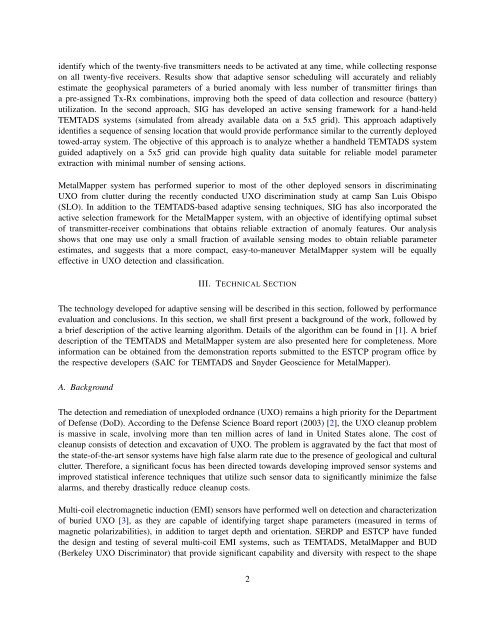INTERIM REPORT - Strategic Environmental Research and ...
INTERIM REPORT - Strategic Environmental Research and ...
INTERIM REPORT - Strategic Environmental Research and ...
Create successful ePaper yourself
Turn your PDF publications into a flip-book with our unique Google optimized e-Paper software.
identify which of the twenty-five transmitters needs to be activated at any time, while collecting response<br />
on all twenty-five receivers. Results show that adaptive sensor scheduling will accurately <strong>and</strong> reliably<br />
estimate the geophysical parameters of a buried anomaly with less number of transmitter firings than<br />
a pre-assigned Tx-Rx combinations, improving both the speed of data collection <strong>and</strong> resource (battery)<br />
utilization. In the second approach, SIG has developed an active sensing framework for a h<strong>and</strong>-held<br />
TEMTADS systems (simulated from already available data on a 5x5 grid). This approach adaptively<br />
identifies a sequence of sensing location that would provide performance similar to the currently deployed<br />
towed-array system. The objective of this approach is to analyze whether a h<strong>and</strong>held TEMTADS system<br />
guided adaptively on a 5x5 grid can provide high quality data suitable for reliable model parameter<br />
extraction with minimal number of sensing actions.<br />
MetalMapper system has performed superior to most of the other deployed sensors in discriminating<br />
UXO from clutter during the recently conducted UXO discrimination study at camp San Luis Obispo<br />
(SLO). In addition to the TEMTADS-based adaptive sensing techniques, SIG has also incorporated the<br />
active selection framework for the MetalMapper system, with an objective of identifying optimal subset<br />
of transmitter-receiver combinations that obtains reliable extraction of anomaly features. Our analysis<br />
shows that one may use only a small fraction of available sensing modes to obtain reliable parameter<br />
estimates, <strong>and</strong> suggests that a more compact, easy-to-maneuver MetalMapper system will be equally<br />
effective in UXO detection <strong>and</strong> classification.<br />
III. TECHNICAL SECTION<br />
The technology developed for adaptive sensing will be described in this section, followed by performance<br />
evaluation <strong>and</strong> conclusions. In this section, we shall first present a background of the work, followed by<br />
a brief description of the active learning algorithm. Details of the algorithm can be found in [1]. A brief<br />
description of the TEMTADS <strong>and</strong> MetalMapper system are also presented here for completeness. More<br />
information can be obtained from the demonstration reports submitted to the ESTCP program office by<br />
the respective developers (SAIC for TEMTADS <strong>and</strong> Snyder Geoscience for MetalMapper).<br />
A. Background<br />
The detection <strong>and</strong> remediation of unexploded ordnance (UXO) remains a high priority for the Department<br />
of Defense (DoD). According to the Defense Science Board report (2003) [2], the UXO cleanup problem<br />
is massive in scale, involving more than ten million acres of l<strong>and</strong> in United States alone. The cost of<br />
cleanup consists of detection <strong>and</strong> excavation of UXO. The problem is aggravated by the fact that most of<br />
the state-of-the-art sensor systems have high false alarm rate due to the presence of geological <strong>and</strong> cultural<br />
clutter. Therefore, a significant focus has been directed towards developing improved sensor systems <strong>and</strong><br />
improved statistical inference techniques that utilize such sensor data to significantly minimize the false<br />
alarms, <strong>and</strong> thereby drastically reduce cleanup costs.<br />
Multi-coil electromagnetic induction (EMI) sensors have performed well on detection <strong>and</strong> characterization<br />
of buried UXO [3], as they are capable of identifying target shape parameters (measured in terms of<br />
magnetic polarizabilities), in addition to target depth <strong>and</strong> orientation. SERDP <strong>and</strong> ESTCP have funded<br />
the design <strong>and</strong> testing of several multi-coil EMI systems, such as TEMTADS, MetalMapper <strong>and</strong> BUD<br />
(Berkeley UXO Discriminator) that provide significant capability <strong>and</strong> diversity with respect to the shape<br />
2

















